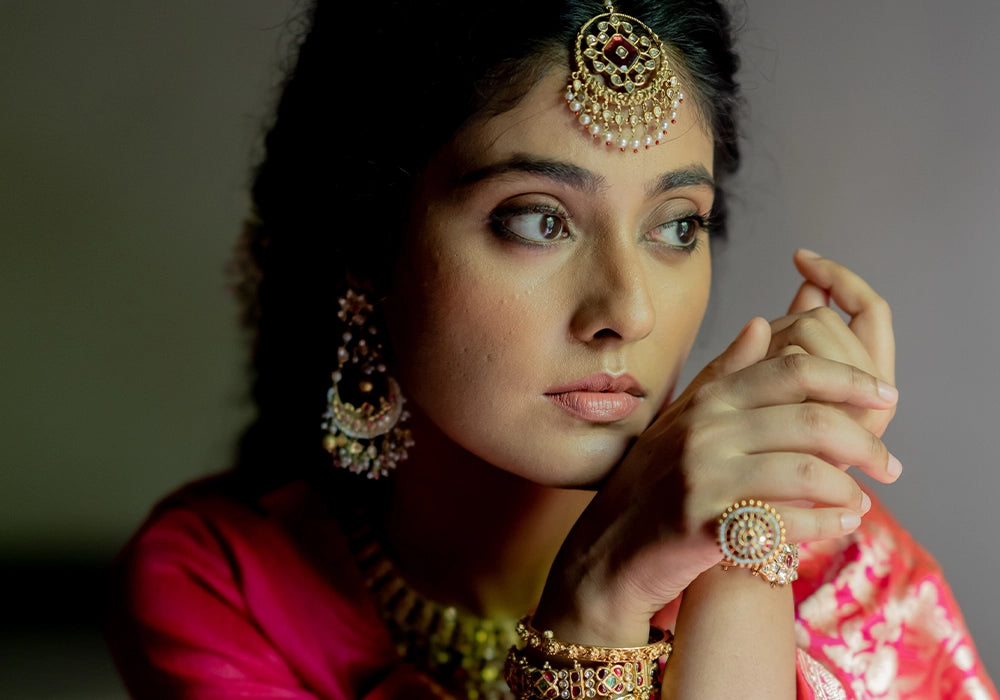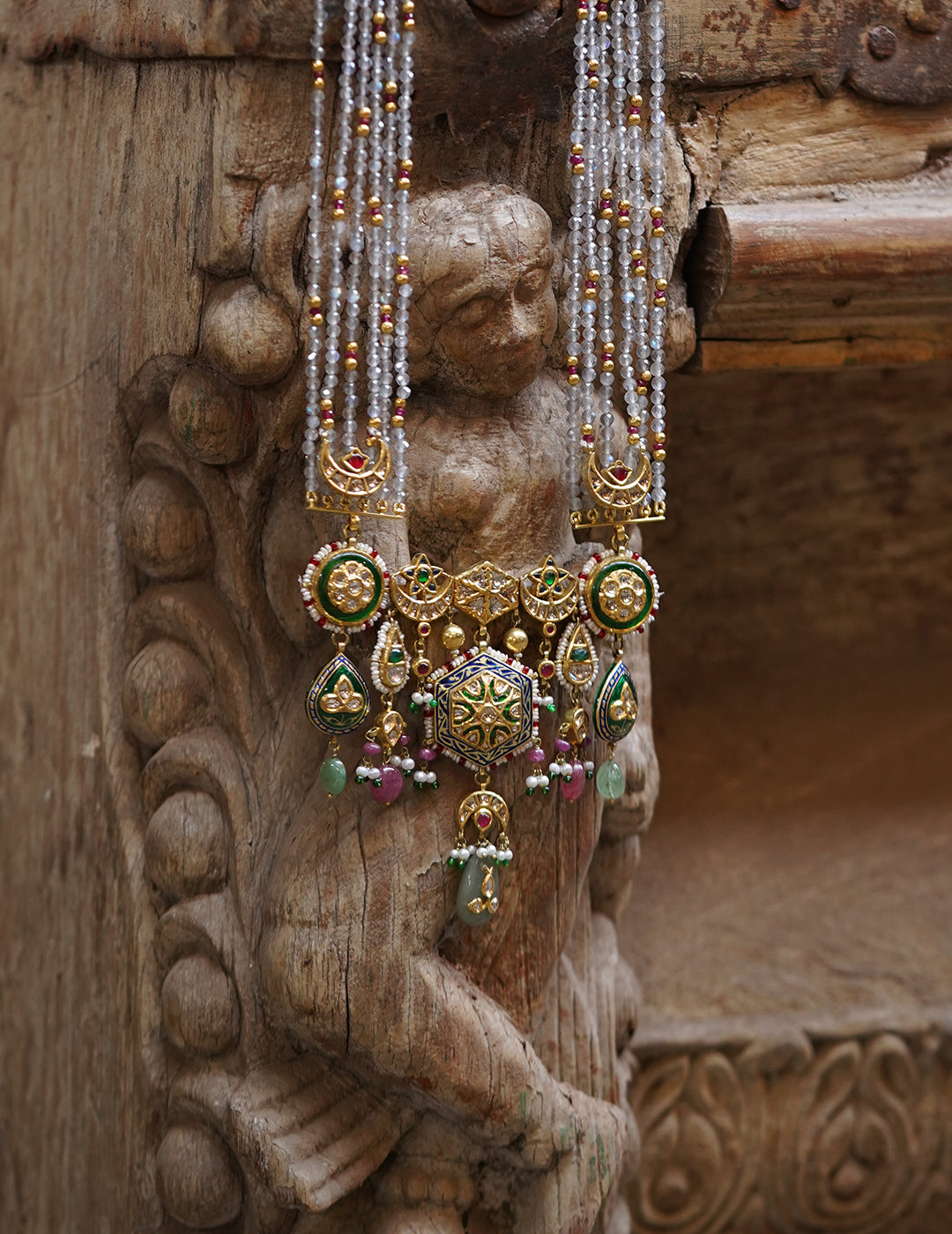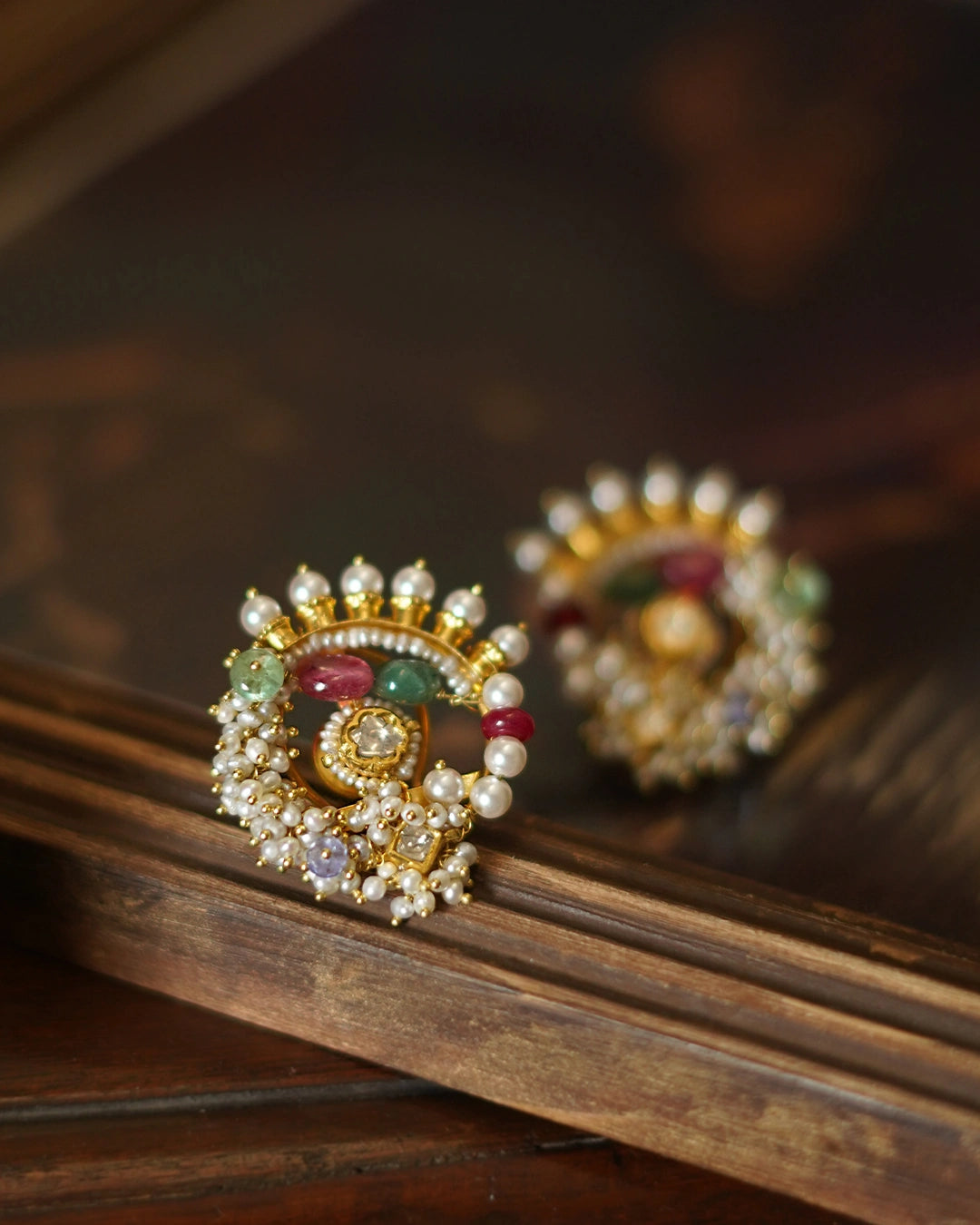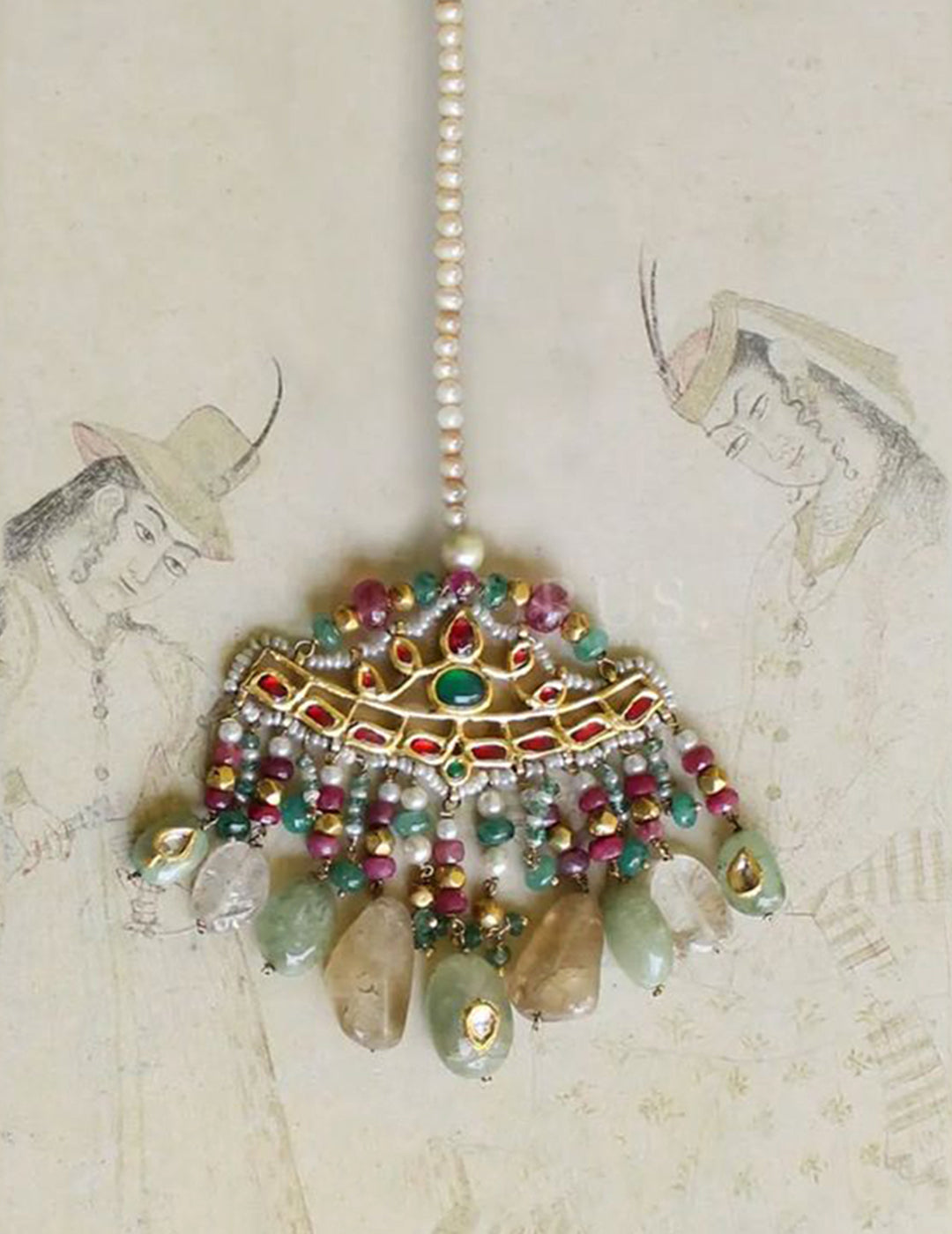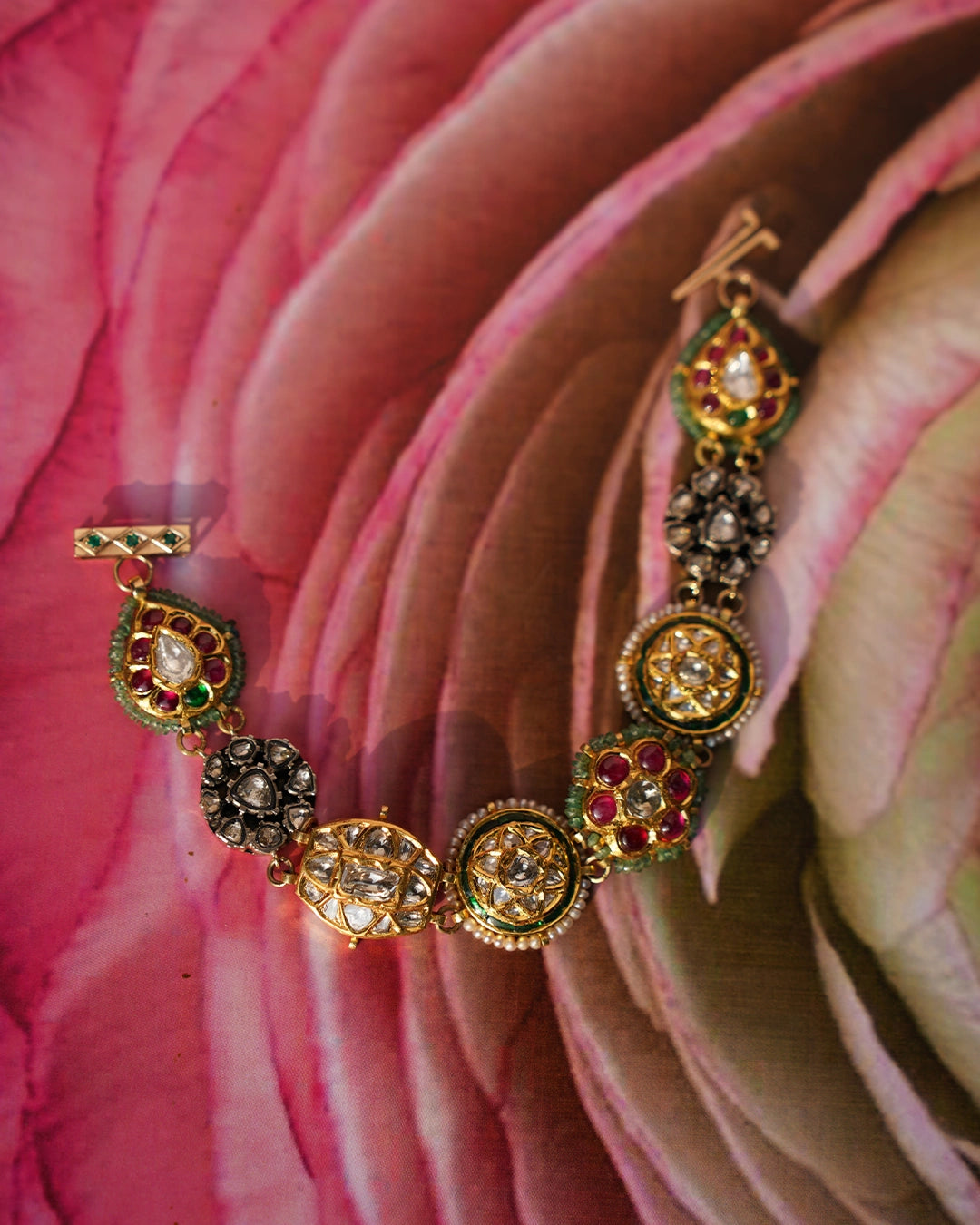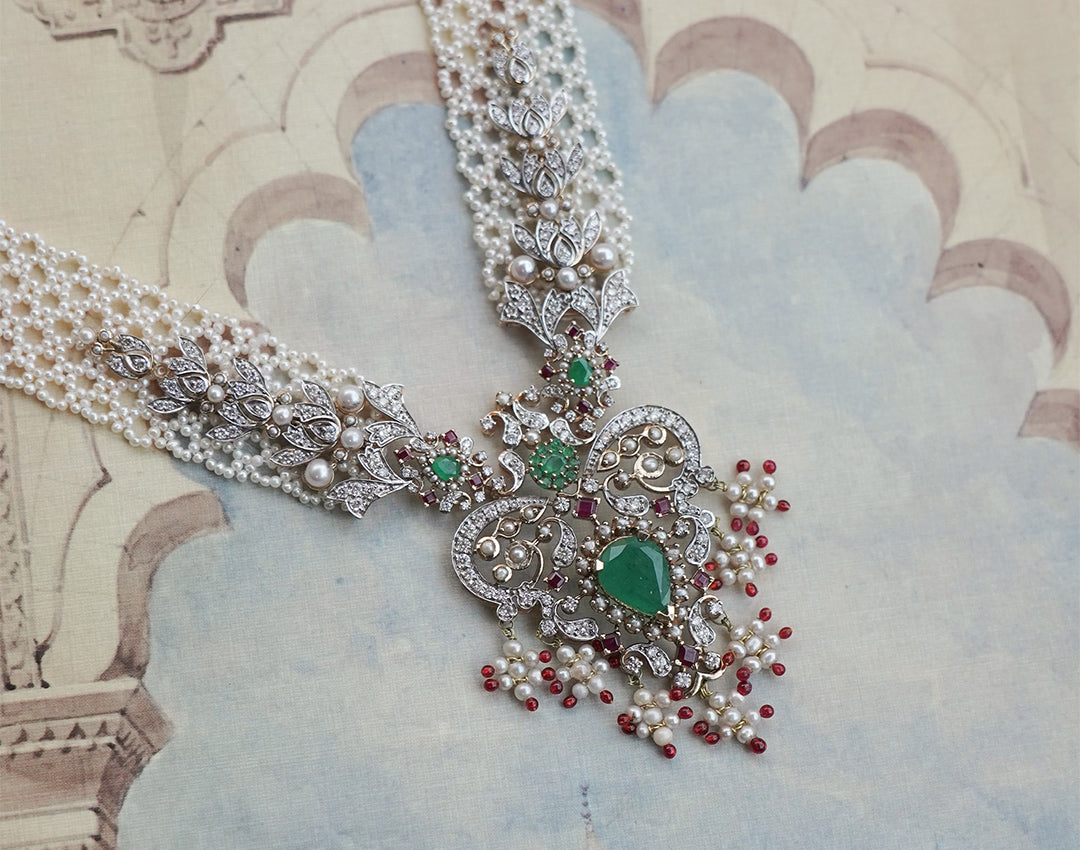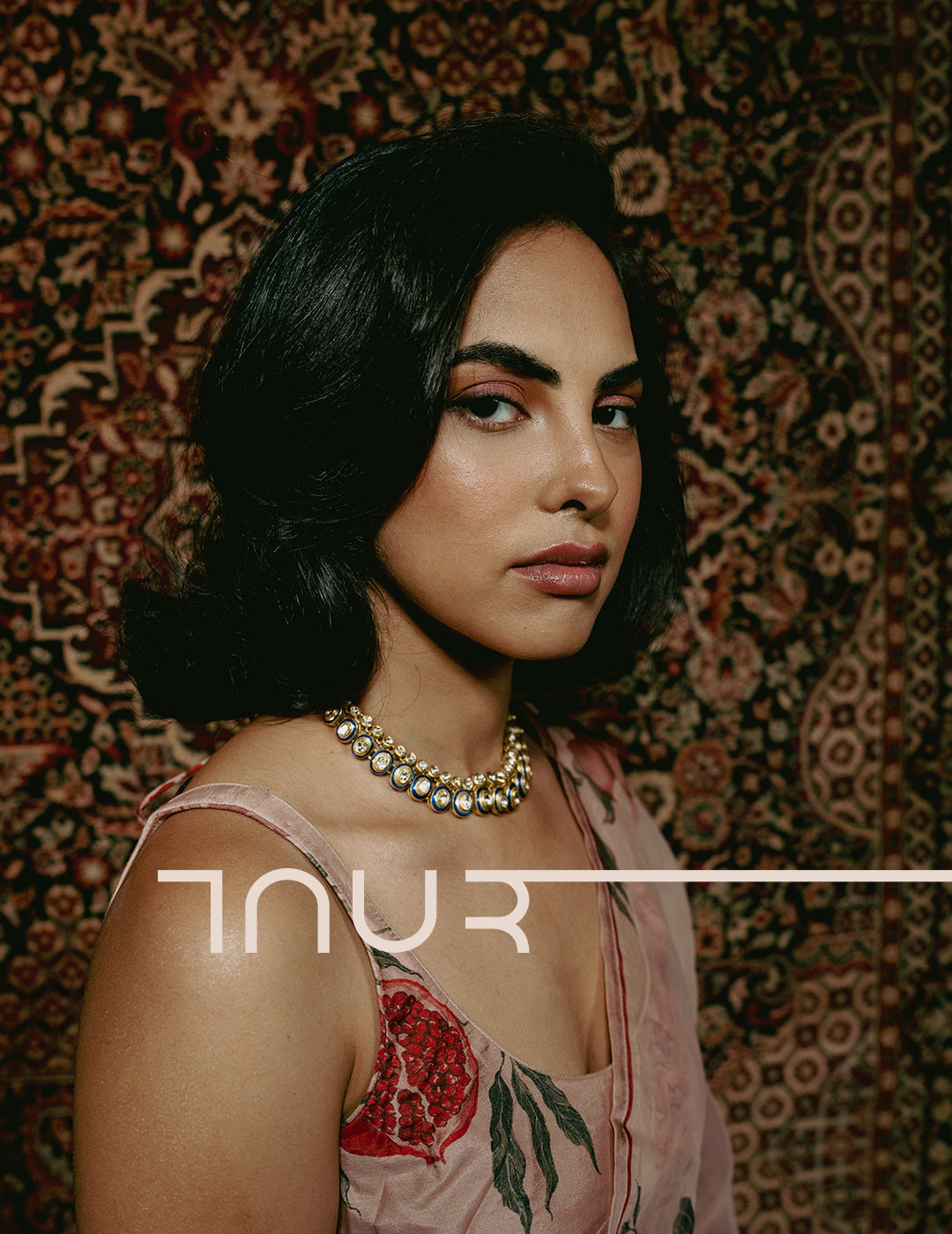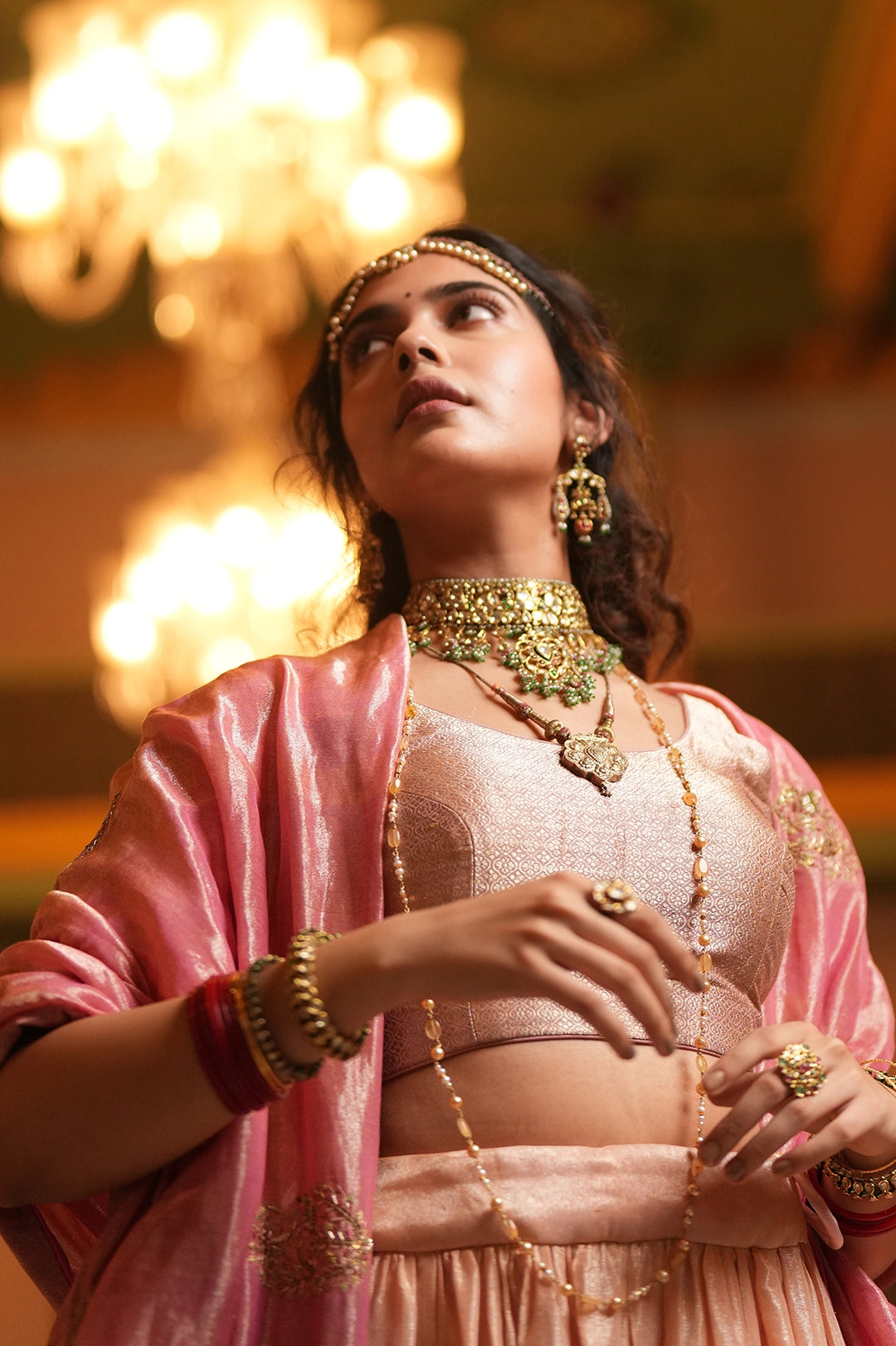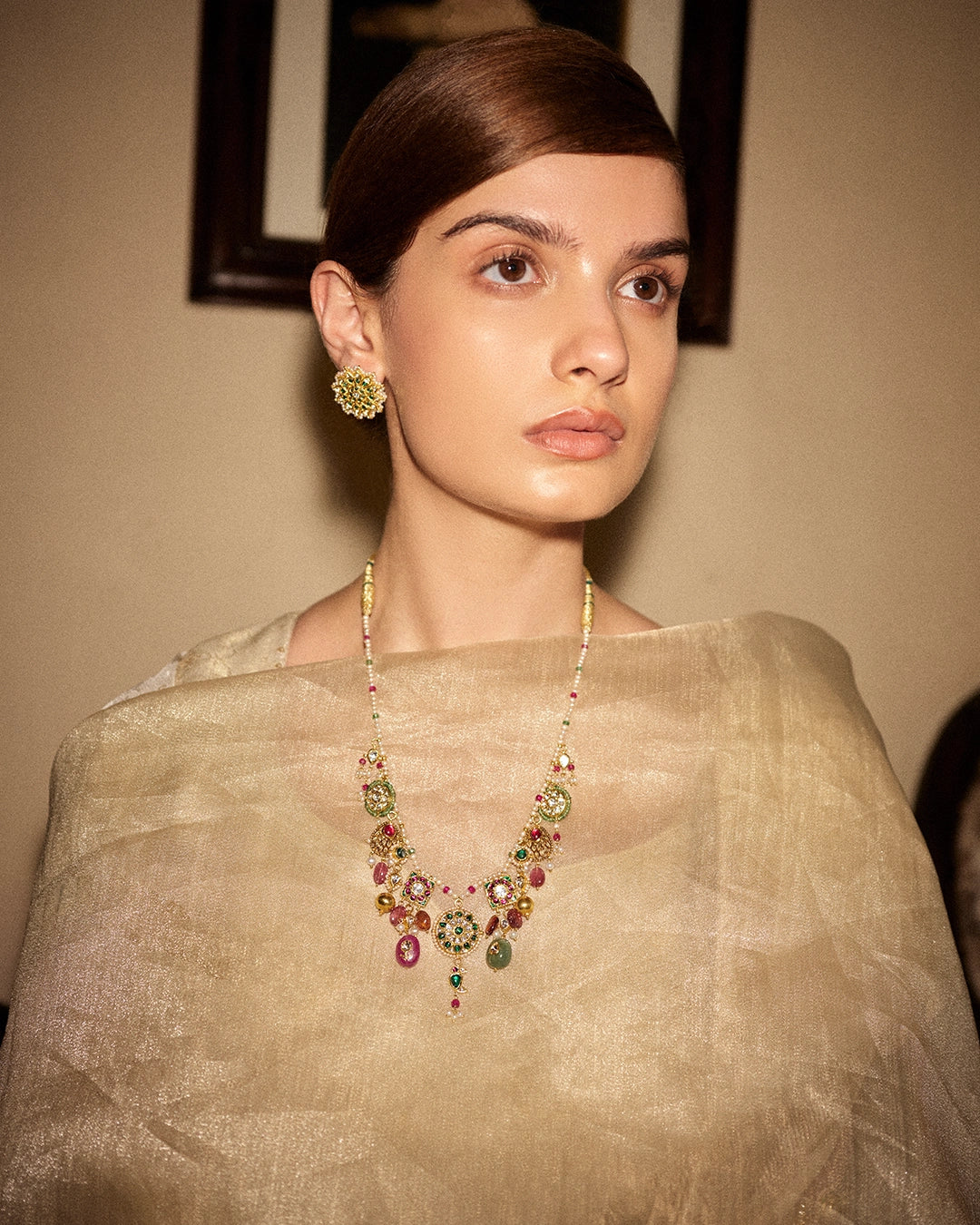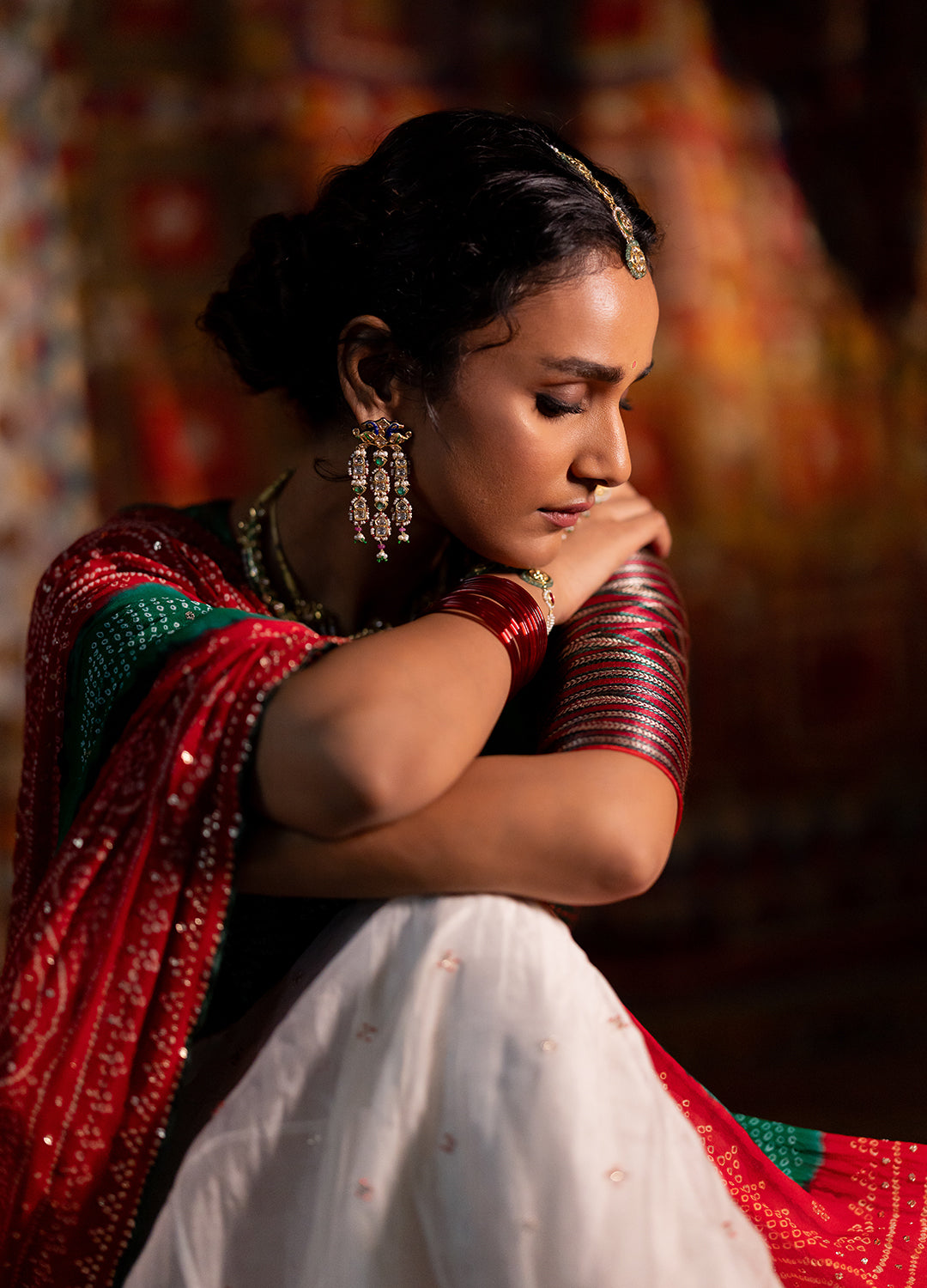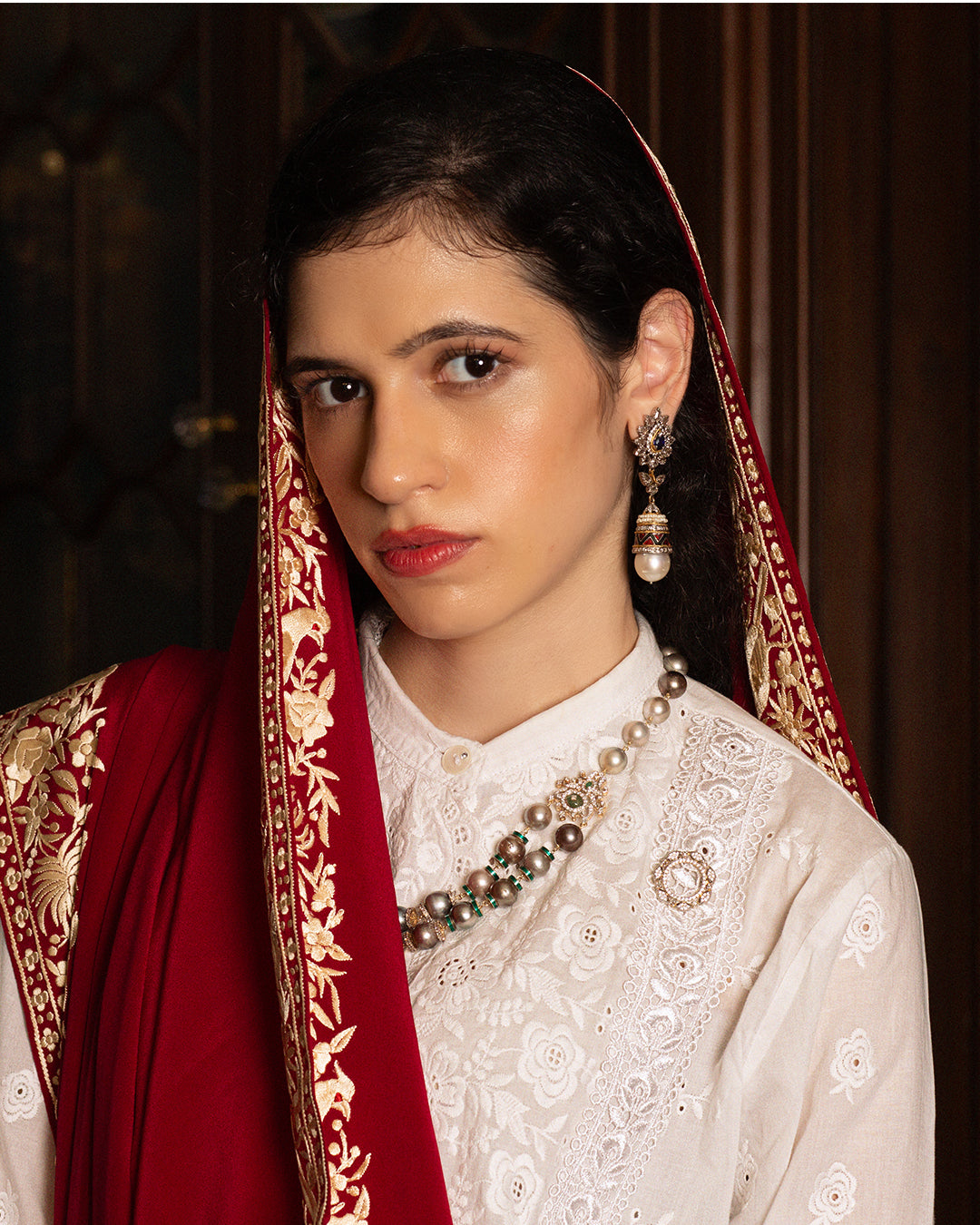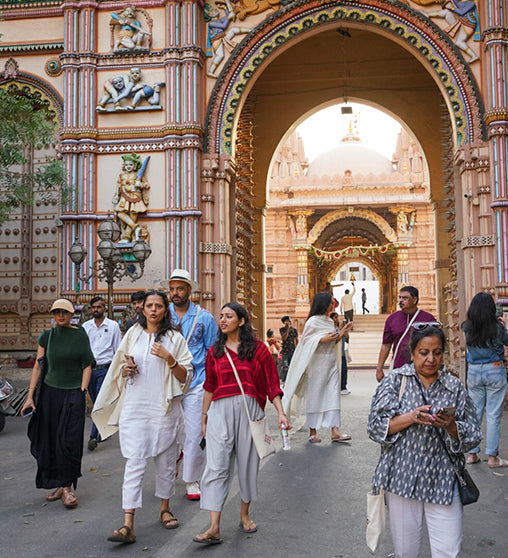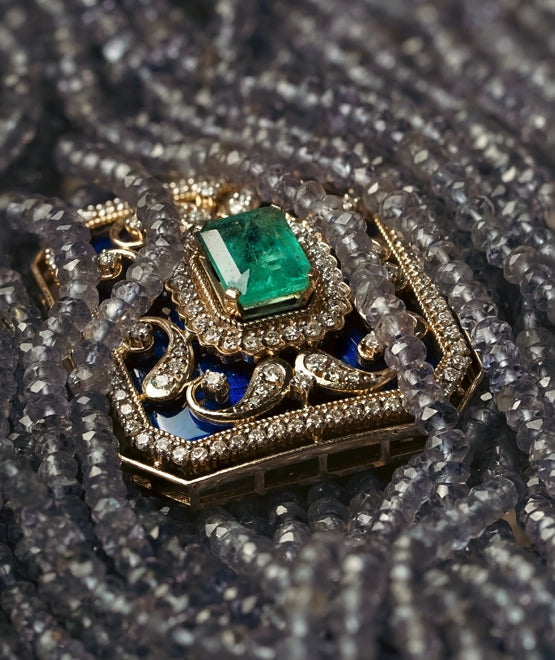The name Chandbali comprises two words-Chand refers “moon” and Bali is “earrings”. With the crescent moon shape as the main element of design, the chandbali earrings are set intricately with crystals and fringed with tiny pearls. From the early iterations of Rajasthan's royal Rajput dynasties to Hyderabad's Nizams, the presence of chandbali earrings can be traced back to the early rulers.

to realise the sense of power that such jewels as earrings and anklets
lend their wearers; she knows the full delight of swinging jewels
touching her cheek at every step, and the fascination of the
tinkling bells upon her anklets.
- Ananda.K.Coomaraswamy
The Wisdom of Ananda Coomaraswamy: Reflections of Indian Art, Life, and Religion.

North India, late nineteenth century, a crescent-shaped jewel that could be a part of a maang tikka or a turban ornament, channel-set with emeralds. Image courtesy: Sharma and Varadarajan, Handcrafted Indian Enamel Jewelry
Through the years, jewelry has been an expression of the country’s aesthetic and cultural diversity. No other land has known adornment styles as varied as ours and it is only fair that we put a spotlight on each of these bearers of legacy. Jewelry was always driven by more than an aesthetic-it had scientific, socio-economical and astrological ties. We hope to take a closer look at this relationship and unravel the layered importance of adornments.

Sita, Detail of Pahari Painting
Source – Artchives India
In the archives, through pictures and portraits of the royal families, be it the Mughals, the Nizams of Hyderabad or the Rajputs of Rajasthan, we come across a crescent maang tikka or sarpench (aigrette). The crescent, famously known chand motif, is one of the most commonly seen motifs in Indian art, architecture, textile and jewellery. What we are talking about today, is the name that’s now part of every woman’s wardrobe: the “chand-baalis”!
These are a form in earrings, which we are sure you must have come across at least once in your life, but do you know their story?
The Blending of Indo-Muslim Influences
We believe that the crescent, among few other popular motifs, came into existence when the Indian and Islam (Mughal) cultures influenced each other. Read this excerpt from “Indian Jewels that Enchanted the World by Larisa Peshekhonova” that throws light on the style and motifs that the Mughals and Islam brought into the Indian subcontinent and how the Indian forms worked in tandem:
“When the first Mughal court settled in India, arts and crafts in the subcontinent were already highly sophisticated, but Islam brought fresh and original creativity to the Hindu style, which is apparent in the architecture, the painting, the music, and a whole variety of arts and crafts. The human and deistic motifs on temple architecture place more emphasis on flora and fauna in general, whereas more particular animal figures such as the heads of lions and elephants came into prominence as finials for jewelry, especially kara bangles and neck ornaments.

This typical Muslim design was also known as a necklace in ancient Bengal. Image courtesy: Traditional Jewelry of India by Oppi Untracht.
The combination of sun and crescent moon became a popular design in this period, as did fish, peacocks, parrots, mangoes and different forms of lotus and other flower motifs. Flowers had long been important in Islamic culture where they were generally seen as symbols of the divine realm and associated with the Garden of Paradise. Many of these motifs came to be secularized as Hindu and Muslim influences intermingled.

The young Rajkumari Amrit Kaur, daughter of the erstwhile Maharajah of Faridkot. Image courtesy: AFP/Getty Images.
The motifs on the pillars of the mosques were taken from Hindu and Jain temples and the splendor of the stonework with its décor of geometric motifs, floral arabesques and Koranic inscriptions, expressed the genius of the Indian sculptors in that period. Brought from Persia, mirror art embellished many palaces, where the walls and ceilings were dotted with pieces of mirror. Oil lamps placed on the floor made the place a truly enchanting Sheesh Mahal (Palace of Mirrors).”
From the Mughals to Maharanis and the Movies - Journey of the Chandbali Earrings
The royals of India lived life king size, as they should have. They commissioned the best art, enchanted and influenced the world with their jewels. Come to think of it, after royalty, our society is vastly influenced by cinema. From the era of the black and white film to the modern Bollywood to OTT, Indians seek inspiration from their beloved stars, their style and choices. Distinct styles of chandbali earrings were documented across Mughal royalty and that of Baroda and Surat. A few of them are cited below:

Portrait of a Bibi, Lucknow (Oudh State) 1785

Uttar Pradesh, early nineteenth century. A part of a crescent shaped maang tikka holding a sun shaped motif on the top signifying the blend of Islamic and Hindu influence on art and fashion.
Image and text reference: Traditional Jewelry of India by Oppi Untracht
 London, c.a 1900. A pair of diamond chandbali earrings on display at the Victoria and Albert Museum, donated by Princess Naheed Mazharuddin Khan of Surat, featuring rose cut diamonds from the famed Golconda mines. The design of these earrings places them within the tradition of Mughal jewelry, but the open settings of the diamonds reflect the influence of Europe.
London, c.a 1900. A pair of diamond chandbali earrings on display at the Victoria and Albert Museum, donated by Princess Naheed Mazharuddin Khan of Surat, featuring rose cut diamonds from the famed Golconda mines. The design of these earrings places them within the tradition of Mughal jewelry, but the open settings of the diamonds reflect the influence of Europe.

Paris, ca. 1950
Crescent shaped diamond and emerald earrings by Van Cleef & Arpels, formerly in the collection of the maharani Sita Devi of Baroda. Seems like ‘chandbalis’ were all the rage back in the 1900s!
When we think of the best, most extravagant costumes that Bollywood has had to offer, we undoubtedly think of movies like Mughal-e-Azam, Rekha in Umrao Jaan, Meena Kumari in Pakeezah, Aishwarya Rai in Jodha Akbar, and Deepika Padukone in Sanjay Leela Bhansali movies. The heavily embroidered lehengas, the glittering gold saree borders, and the stunning passas, chandbali earrings and the haathphools.

 Clockwise - 1. Rekha in a chand shaped maang tikka in movie Umrao Jaan.
Clockwise - 1. Rekha in a chand shaped maang tikka in movie Umrao Jaan.
- Deepika Padukone wearing a crescent shaped maang tikka in the movie Bajirao Mastani.
- Deepika Padukone in the movie Ram Leela wearing statement chandbali earrings.
From the head ornaments, the moon shape gradually made its way to other items of jewelry, like nose-ring and the chandbali - a classic Indian style of earrings that has had its stronghold over Indian shringar.
When it comes to modern-day chandbalis, the designs have transformed into various colours, shapes, sizes and materials, with the polki chandbali earrings competing with the jhumka style chandbali earrings to stand out as the most popular ones. While that is the popular sight, our traditional Indian earrings have a lot more styles to offer-the minimal diamond chandbalis, the antique chandbalis, the nath-inspired chandbalis.
The Various Styles of Chandbali Earrings We See Today
Oversized chandbali earrings, to the ones with sahara, and then multi layered options, these earrings are versatile and we see them in a plethora of variations today.
The nath, or the nosepin, has been a quintessential piece of jewelry for Indians. It makes a part of the ‘sola shringar’ of an Indian bride and is even worn by tribal women in the country. The nath has also inspired chandbali earring designs since ages.

Left to right - 1. Himachal Pradesh, early twentieth century.
A gold crescent nose ring (bulaq or kundu) featuring a design of two birds on green enamel.
This form of nose ring hangs below a hole pierced through the septum of the nose and can range from being a modest ring to a large ornament, which might cover the mouth and need to be lifted up when eating. Sometimes a bulaq is called a nathni, denoting a smaller size.
Source: Untracht, Traditional Jewelry of India
2. Old Punjab, Lahore, Amritsar, Nineteenth century
Gold nose ring (nath) in the form of a curved fish carrying a bird (peacock), kundan-set with cabochon rubies, turquoise, and multi-colored moonstones with white and turquoise glass beads.
This specific design 'fish carrying a peacock' is worn by women of the Sikh community in the Punjab. Designs with different birds are worn by women in the Muslim community in Uttar Pradesh.

Aurus chandbali earrings in tones of pink and white, these earrings with polki (uncut diamonds), pearls and gemstones are inspired from the traditional nath design.

Aurus chandbali earrings in tones of pink, green and yellow, these earrings with polki (uncut diamonds), pearls and gemstones hold colors perfectly suited for Indian festivities.
Why Leave the Diamonds Behind?
The unmatched sparkle that diamonds offer can turn any night into a starry night afterall!

A Punjabi bride wearing traditional Punjabi ornaments: a kundan chand maang tikka and a chand-shaped nose ring (nath). Image courtesy: Traditional Jewelry of India.
